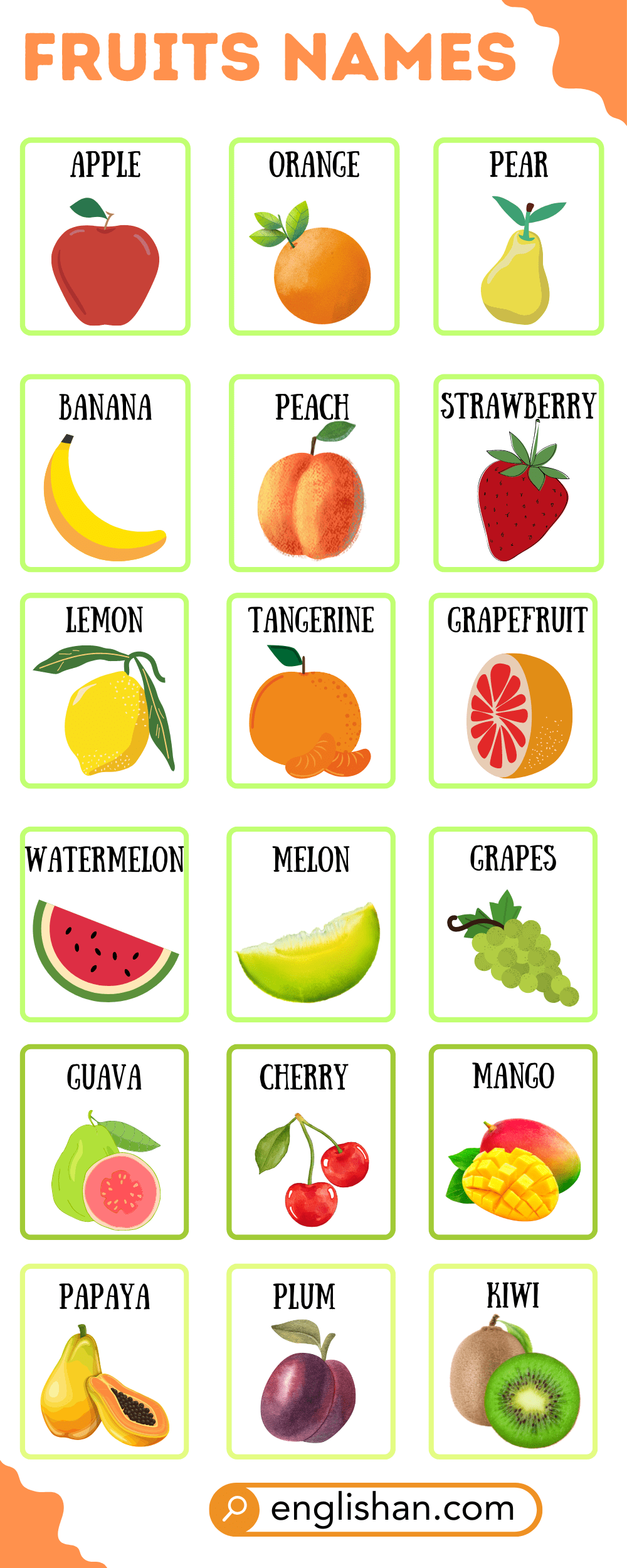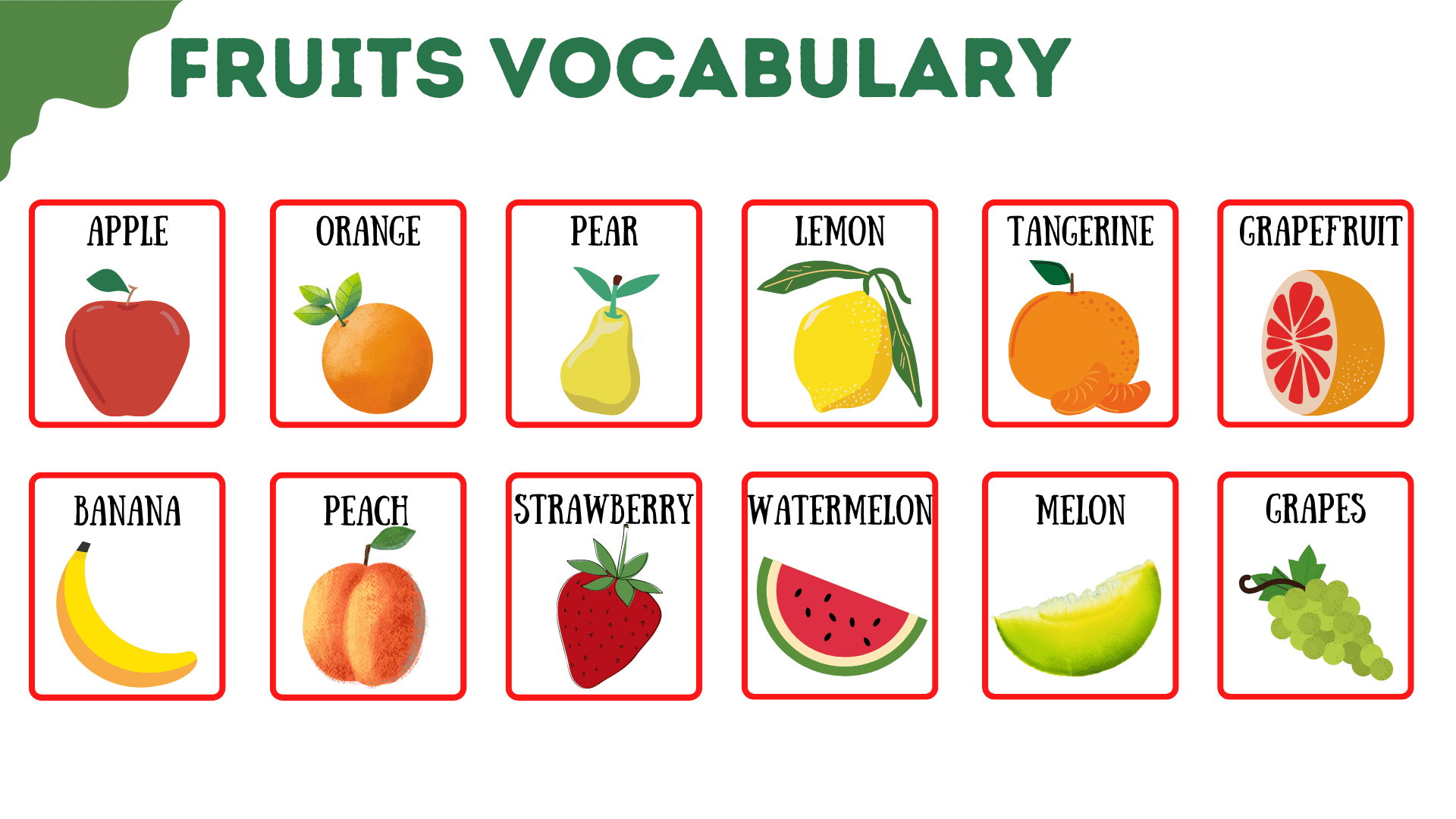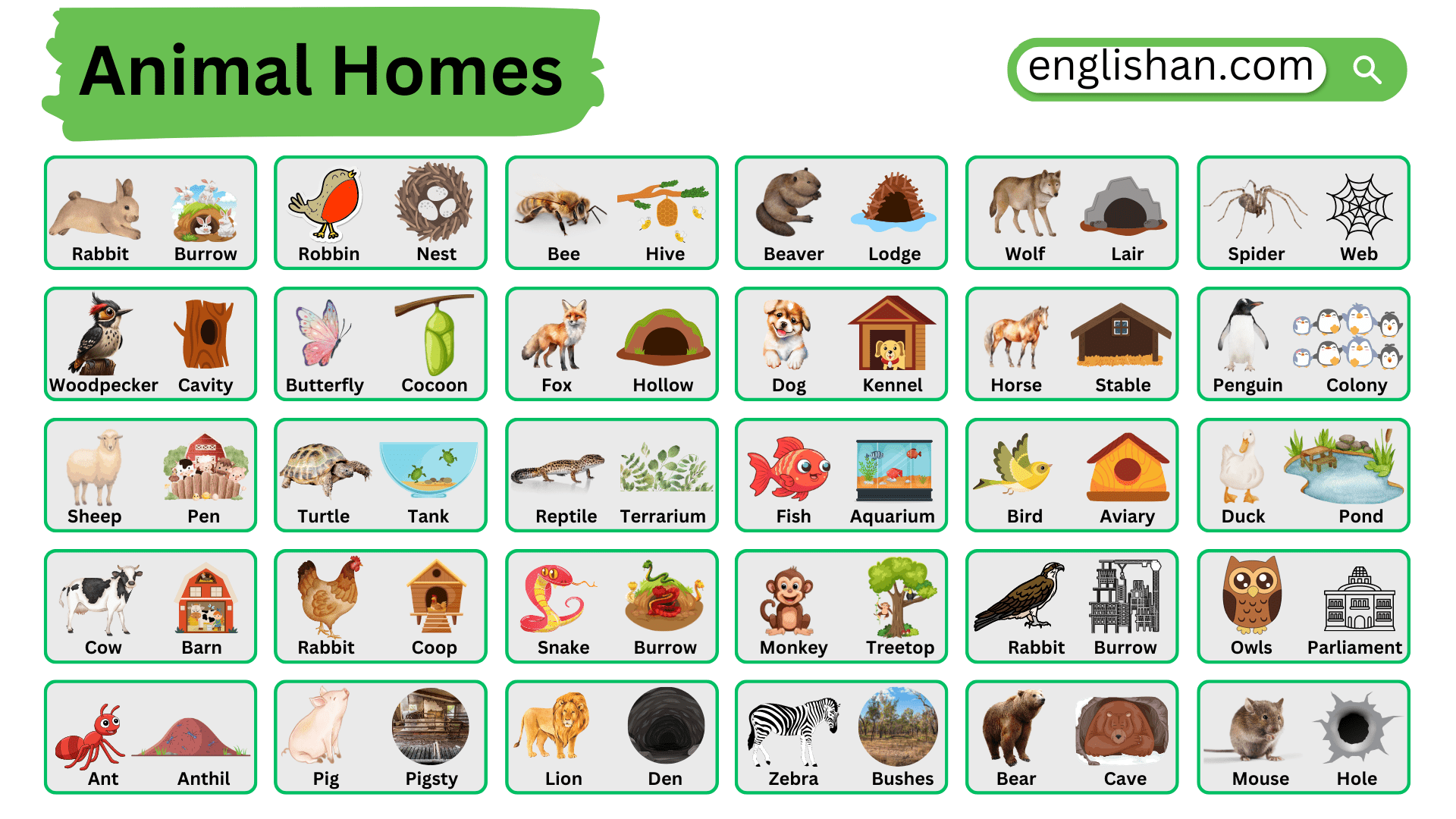Contents
When we talk about Fruits Names, we’re talking about all the different kinds of fruits we can eat. Learning Fruits Names helps us know what we’re eating and makes it easier to talk about our favorite fruits. This is a simple start to knowing more about fruits.
Fruits Names in English

Fruits Names List
Fruits Names | Fruits Pictures |
strawberry |  |
star fruits |  |
pomegranate |  |
raspberry |  |
kiwi |  |
plum |  |
coconut |  |
watermelon |  |
avocados |  |
grapes |  |
peach |  |
cherry |  |
orange |  |
melon |  |
fig |  |
mango |  |
apricot |  |
papaya |  |
apple |  |
jack fruit |  |
Fruit Names and Their Benefits
Apple: Apples are good for us. They have fiber which helps our stomach and things that are good for our heart.
Banana: Bananas are great for giving energy. They also have something called potassium that helps our muscles work right.
Orange: Oranges have lots of vitamin C. This vitamin is good for keeping us from getting sick.
Strawberry: Strawberries have many good things like vitamins. They also help reduce swelling in our body.
Grapes: Grapes are good for the heart. They have something special called resveratrol in them.
Mango: Mangos are filled with vitamins A and C. These vitamins help our stomach and skin.
Kiwi: Kiwis give us a lot of vitamin C. This is good for our skin and helps protect us from sickness.
Pineapple: Pineapples have something called bromelain. This helps our stomach and reduces swelling.
Watermelon: Watermelons have a lot of water and are not heavy in calories. They’re also good for the heart.
Blueberry: Blueberries have many things that help the brain. They are also filled with antioxidants.
Pomegranate: Pomegranates have many things that are good for the heart and skin.
Pear: Pears are full of fiber. This helps our stomach work well.
Cherry: Cherries help reduce swelling in our body. They have something special called anthocyanins.
Papaya: Papayas have something that helps our stomach and skin. This thing is called papain.
Avocado: Avocados have good fats. These fats are good for the brain and heart.
Cranberry: Cranberries are good for preventing infections in the urinary system.
Apricot: Apricots have lots of vitamins A and C. These are good for our skin.
Blackberry: Blackberries are full of fiber and things that help our stomach.
Fig: Figs have fiber and minerals. These are good for our bones and stomach.
Lemon: Lemons have lots of vitamin C. They help our stomach and clean our body.
Guava: Guavas have a lot of vitamin C. This helps protect us from sickness.
Peach: Peaches have vitamins A and C. These vitamins are good for our skin.
Plum: Plums have things that are good for our bones.
Raspberry: Raspberries have fiber. This helps our stomach and can help us keep a healthy weight.
Dragon Fruit: Dragon fruits have fiber and other good things. They help our stomach.
Kiwifruit: Kiwifruits have vitamin K. This is good for our blood and bones.
Passion Fruit: Passion fruits help protect us from getting sick because they have many good things in them.
Cantaloupe: Cantaloupes have vitamins A and C. They also give our body water.
Lychee: Lychees are good for our skin because they have vitamin C.
Coconut: Coconuts give our body water and nutrients.
Jackfruit: Jackfruits are full of fiber which is good for our stomach.
Pitaya (Dragon Fruit): Pitayas are filled with things that are good for our skin and stomach.
Black Currant: Black currants help protect us from sickness because they have vitamin C.
Apricot: Apricots are good for our eyes because they have something called beta-carotene.
Nectarine: Nectarines are light in calories and good for our skin.
Star Fruit: Star fruits have less sugar and are good for our stomach.
Gooseberry: Gooseberries are good for our hair and stomach because they have vitamin C.
Cranberry: Cranberries are good for the urinary system because they have special things in them.
Fig: Figs help our bones and stomach because they have fiber.
Date: Dates are sweet and chewy fruits. They give energy and are packed with nutrients good for our bones.
Grapefruit: Grapefruits can taste sweet or a bit bitter. They’re filled with vitamins that can boost our heart health.
Tangerine: Tangerines are like little oranges. They’re juicy, sweet, and full of vitamins.
Durian: Durians have a strong smell, but many people love their creamy taste. They offer lots of energy.
Rambutan: Rambutans are sweet fruits that look a bit hairy on the outside. Inside, they’re juicy and tasty.
Clementine: Clementines are small and sweet. They’re easy to peel and perfect for a quick snack.
Mulberry: Mulberries are small, sweet fruits. They’re good for our body and can help make our bones stronger.
Currant: Currants can be black, red, or white. They’re tiny but packed with good stuff for our health.
Persimmon: Persimmons are sweet and can be soft or crunchy. They’re filled with vitamins that are good for our eyes and skin.
Honeydew Melon: Honeydew melons are sweet and juicy. They help keep our body hydrated because they have a lot of water in them.
Boysenberry: Boysenberries taste sweet and a little tart. They’re filled with things that help keep our body healthy.
Custard Apple: Custard apples have a creamy texture. They’re sweet and packed with vitamins and minerals.
Types of Fruits
1. Citrus Fruits
Definition: Fruits that come from flowering trees and shrubs. They are known for their juicy segments and slightly thick skins.
Examples:
- Orange
- Lemon
- Lime
- Grapefruit
- Tangerine
- Pomelo
2. Berries
Definition: Small and juicy fruits, often with seeds inside. Many can be eaten whole.
Examples:
- Strawberry
- Blueberry
- Raspberry
- Blackberry
- Cranberry
- Gooseberry
3. Stone Fruits (or Drupes)
Definition: Fruits that have a large, hard pit or “stone” inside. The flesh of the fruit is usually sweet or tart.
Examples:
- Peach
- Cherry
- Plum
- Apricot
- Nectarine
4. Melons
Definition: Large, juicy fruits with a hard outer skin and a soft inner flesh. Often eaten in slices.
Examples:
- Watermelon
- Cantaloupe
- Honeydew
- Crenshaw
- Galia
5. Tropical Fruits
Definition: Fruits that grow in tropical climates. They often have unique flavors, shapes, and colors.
Examples:
- Mango
- Pineapple
- Banana
- Papaya
- Coconut
- Guava
6. Pomes
Definition: Fruits that have a central, seed-containing core surrounded by a thick layer of flesh.
Examples:
- Apple
- Pear
- Quince
7. Grapes
Definition: Small, round, juicy fruits that grow in clusters on vines.
Examples:
- Green grapes
- Red grapes
- Concord grapes
- Muscat grapes
8. Nuts and Seeds
Definition: Technically fruits, these have a hard outer shell that usually needs to be cracked open to reveal the edible seed inside.
Examples:
- Almond (the seed inside the fruit)
- Walnut
- Chestnut
- Cashew (the seed of the cashew apple)
9. Cucurbits
Definition: Fruits from the gourd or squash family, often grown on vines. They can be sweet or savory.
Examples:
- Pumpkin
- Cucumber (yes, it’s technically a fruit!)
- Squash
- Zucchini
10. Exotic or Uncommon Fruits
Definition: Fruits that might not be familiar to everyone, especially depending on where you live. They often come from specific regions or climates.
Examples:
- Dragon fruit (or Pitaya)
- Durian
- Jackfruit
- Passion fruit
- Rambutan
- Lychee
11. Fleshy Fruits
Definition: Fruits that are soft when ripe and often have a sweet or tart flavor.
Examples:
- Kiwi
- Fig
- Date
- Tomato (yes, it’s also technically a fruit!)
- Persimmon
12. Aggregate Fruits
Definition: Fruits that develop from the merging of several ovaries that were separate in a single flower.
Examples:
- Blackberry (also a berry, but specifically an aggregate)
- Raspberry (same as the blackberry in terms of category)
- Boysenberry
- Strawberry
13. Multiple Fruits
Definition: Fruits that form from a cluster of flowers (called an inflorescence). The fruits merge together as they grow.
Examples:
- Pineapple
- Fig (also a fleshy fruit, but specifically a multiple fruit)
- Osage-orange
- Breadfruit
FAQs
Here are 10 fruit names:
1. Apple
2. Banana
3. Cherry
4. Orange
5. Mango
6. Grape
7. Strawberry
8. Pineapple
9. Pear
10. Kiwi
Here are 12 fruit names:
1. Watermelon
2. Pomegranate
3. Lemon
4. Lime
5. Apricot
6. Blueberry
7. Raspberry
8. Blackberry
9. Papaya
10. Coconut
11. Dragonfruit
12. Tangerine
Here are some fruit names that end in “apple”:
1. Pineapple
2. Crabapple
3. Sweetapple
4. Sugarapple
5. Custard apple
These are the common fruits that include “apple” in their name.
Apologies for the mistake! Here are fruits with 10 letters:
1. Strawberry
2. Watermelon
3. Blackberry
4. Pineapple
5. Cantaloupe
Download High-Quality PDF
You May Also Like






